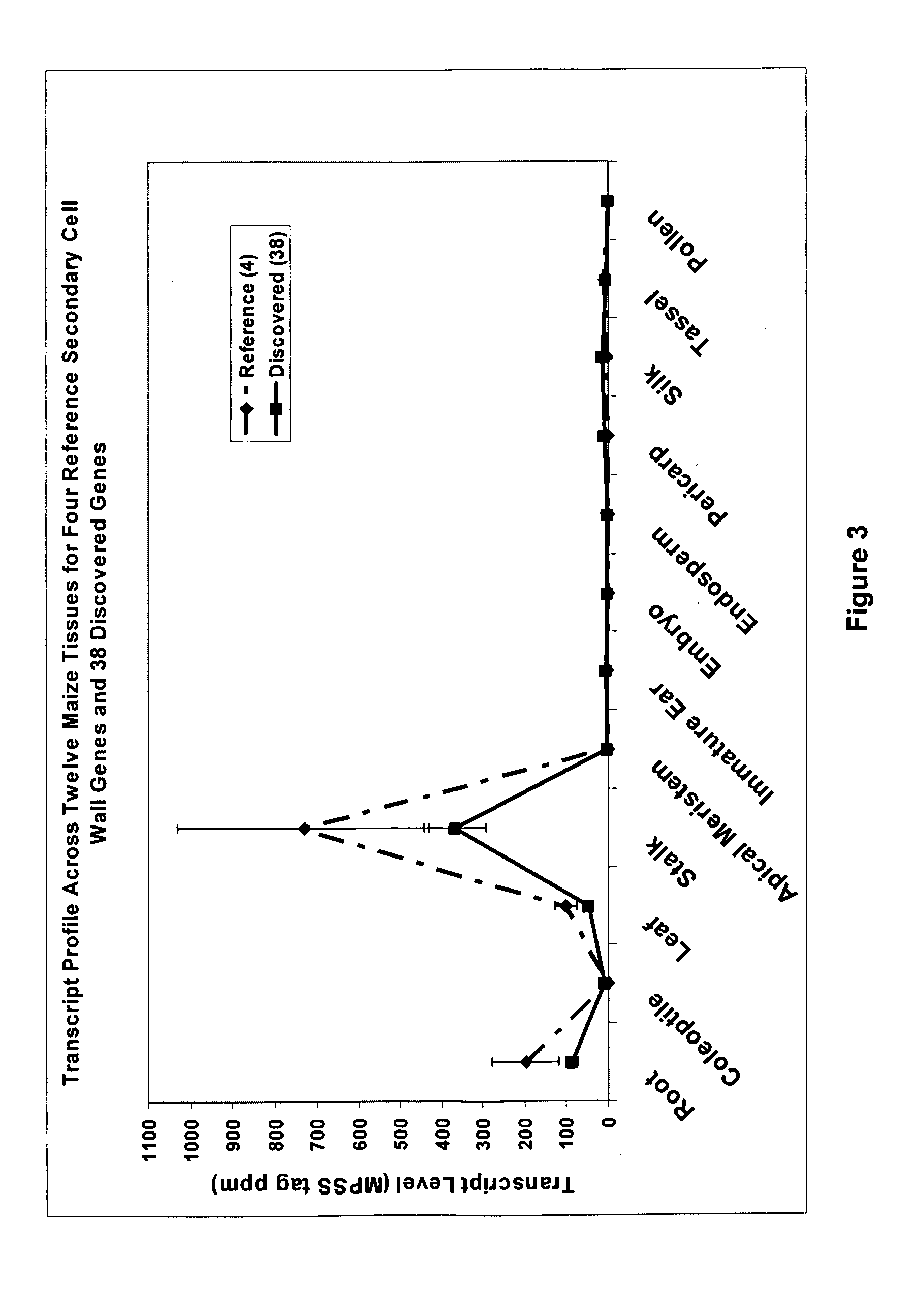Secondary Wall Forming Genes From Maize and Uses Thereof
a technology of secondary wall and maize, which is applied in the field of molecular biology, can solve the problems of increasing the frequency of stalk lodging, and achieve the effects of increasing or decreasing the level of scw polypeptide, increasing plant yield, and increasing grain yield in cereals
- Summary
- Abstract
- Description
- Claims
- Application Information
AI Technical Summary
Benefits of technology
Problems solved by technology
Method used
Image
Examples
example 1
Isolation of SCW Sequences
[0210]Of the genes identified thus for to be involved in plant cell wall formation in maize, the cellulose synthase (CesA) genes, CesA10, CesA11 and CesA12 along with another gene, brittle stalk-2 (Bk2), are of particular interest because of their involvement in secondary cell wall formation (Appenzeller, et al., (2004) “Cellulose synthesis in maize: isolation and expression analysis of the cellulose synthase (CesA) gene family”; Cellulose 11:287-299; Ching, et al., (2006) “Brittle stalk 2 encodes a putative glycosylphosphatidylinositol-anchored protein that affects mechanical strength of maize tissues by altering the composition and structure of secondary cell walls”; Planta 224:1174-1184). As a result, we used these four genes as a reference set with the objective of identifying other genes the expression patterns of which are strongly associated with those of the reference genes. The genes identified with this approach are believed to perform important r...
example 2
Identification of Genes with Strongly Correlated Expression to Reference Genes
[0211]Curation of these genes relied on the similarity of their expression patterns to those from the reference set across a large number libraries in the MPSS™ data set. Pioneer-DuPont has an extensive, proprietary collection of 227 maize tissue / treatment MPSS™ samples that cover a wide range of plant structure and biology. The MPSS samples' data is arrayed in a large table against with correlation analyses can be performed. Pearson's correlation coefficients were calculated across 227 samples for pairs in a way that each pair consisted of one member from the reference and the second member from the remaining tags. In doing so a list of four R and R2 values for each subject tag hit was generated, one to each of the four reference genes (specifically to the tag for those genes). These four values were then averaged and ranked in descending order. Those at the top of the list will have the expression patter...
example 3
Curation of Information about Correlated Genes
[0212]The high scoring MPSS tags were mapped to their respective genes or origins using proprietary and public genomic and transcript sequence resources. Some MPSS tags proved to be alternate tags for the reference genes, and were thus excluded. Where there were ambiguous tag-to-gene matches, the gene of interest was revealed by conferring with other expression data, such as from ESTs, wherein expression in stalk tissue especially was considered evidence of the correct gene. The best description of the gene and its gene product, identifying promoters, transcript regions, ORFs, and conceptual translations were thus obtained. This often required manual curations. Then, the map positions of the genes were also determined, primarily using the proprietary PHD v1.2 map. The conceptual translations of the genes were re-analyzed to discern their respective likely functions. The Swiss-Prot database and various computational tools and other resour...
PUM
| Property | Measurement | Unit |
|---|---|---|
| temperature | aaaaa | aaaaa |
| temperature | aaaaa | aaaaa |
| pH | aaaaa | aaaaa |
Abstract
Description
Claims
Application Information
 Login to View More
Login to View More - R&D
- Intellectual Property
- Life Sciences
- Materials
- Tech Scout
- Unparalleled Data Quality
- Higher Quality Content
- 60% Fewer Hallucinations
Browse by: Latest US Patents, China's latest patents, Technical Efficacy Thesaurus, Application Domain, Technology Topic, Popular Technical Reports.
© 2025 PatSnap. All rights reserved.Legal|Privacy policy|Modern Slavery Act Transparency Statement|Sitemap|About US| Contact US: help@patsnap.com



